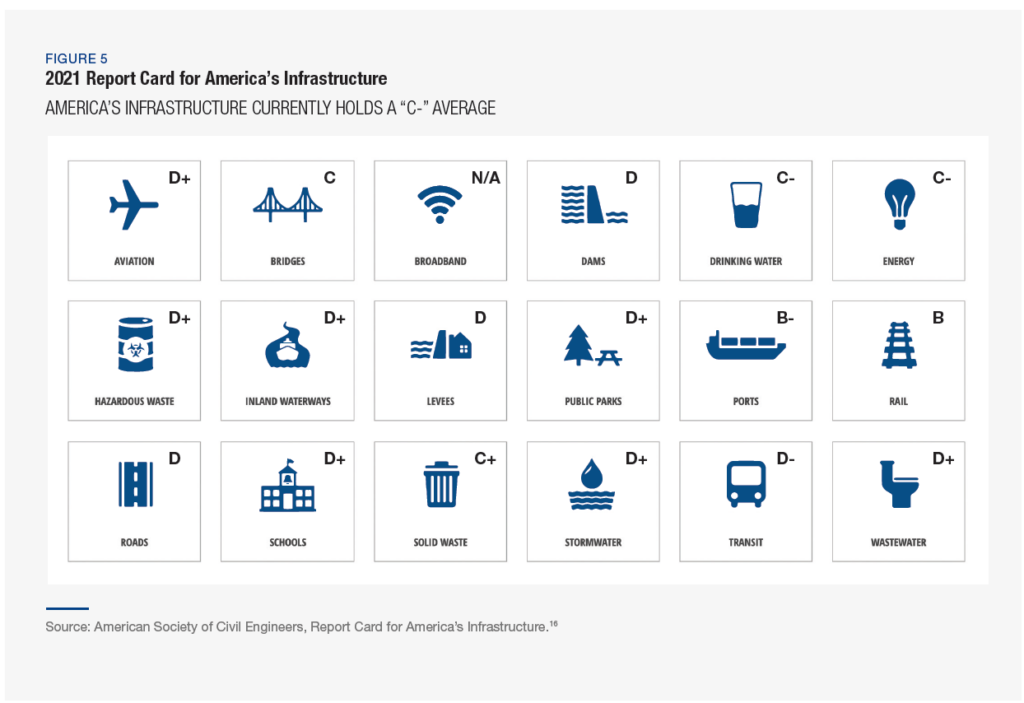Infrastructure investment offers the opportunity to further diversify portfolios, generate steady income, and protect against inflation.
Private infrastructure has emerged as a resilient and strategic asset class within modern investment portfolios. By complementing traditional stocks and bonds, private infrastructure investments can enhance risk-adjusted returns, diversify portfolios, and provide inflation protection. In addition, infrastructure complements other private market sectors like real estate, private credit, and private equity with different return attributes and degrees of economic sensitivity, necessitating a prominent place in well-diversified portfolios. Accelerated by global megatrends such as the growing demand for energy, digital transformation, and aging infrastructure, this asset class is poised to play a pivotal role in meeting evolving economic demands.
The inclusion of infrastructure within traditional investment portfolios has consistently demonstrated the ability to enhance returns while mitigating risk. Private infrastructure offers stability through its low correlation with other asset classes, stable cash flows, and natural hedge against inflation. This paper outlines the defining attributes of private infrastructure, its role in addressing global investment demands, and its unique contributions to portfolio optimization.
Defining Infrastructure
Infrastructure encompasses a broad range of sectors and sub-sectors that collectively underpin the functioning of an economy by enabling trade, mobility, and overall economic activity. It enhances living standards while creating foundations for global growth and human development.
Traditional infrastructure includes key areas such as energy, transportation, and utilities. In recent years, infrastructure has expanded to include communications, data, and network systems. Examples of infrastructure projects include roads, dams, public utilities, wireless cell towers, transmission lines, power plants, data centers, railways, and airports.
These assets play a vital role in supporting both the physical and digital needs of a growing, interconnected economy. They also have high barriers to entry, produce stable, long-term cash flows, and regularly have pricing contracts linked to CPI. These characteristics tend to limit their sensitivity to economic cycles while offering varying degrees of protection during inflationary periods.
Global Megatrends
Several powerful, long-term megatrends are reshaping the global infrastructure landscape and driving substantial investment opportunities. These include the growing demand for energy and the necessary expansion of transmission networks, the ongoing digital transformation of economies and societies, and the urgent need to modernize aging infrastructure in many developed nations. These fundamental drivers—further amplified by population growth and urbanization—are expected to persist for the foreseeable future, necessitating trillions of dollars of investment and creating a robust investment environment across debt and equity.
Energy Supply, Transmission and Storage
The U.S. and the world more generally face significant deficits in energy supply, transmission, and storage. Technological innovations present an enormous demand for electrical power. In parallel, the desire for sustainable and renewable sources adds additional pressure to transform how energy is generated, delivered, and stored. According to Goldman Sachs, the U.S. will need to invest approximately $6.6 trillion in renewable power by 2050.1 More broadly, KKR has forecast that decarbonization to reduce and offset carbon emissions could create a potential $200 trillion opportunity, spanning buildings, transport, electricity generation, fuel production, and other infrastructure categories.2

Transmission, the transportation of energy, and storage, the capture and retention of energy for use at a later time, represent additional essential opportunities alongside power generation. U.S. Department of Energy analysis found that the median new transmission need is 47,000 gigawatt-miles of high voltage lines by 2035, a 57% growth from today’s system. The agency is actively promoting investment with rule changes that create opportunities for transmission projects.3
Further innovations are occurring in a range of areas, from large-scale battery technology that stores renewably generated power for future use to a more active reconsideration of nuclear power. The U.S. Department of Energy projects energy storage deployment will exceed 125 gigawatts by 2050, more than a five-fold increase from 23 gigawatts of installed capacity in 2020.4 The International Atomic Energy Agency (IAEA) has forecast world nuclear capacity to increase by as much as 2.5 times the current capacity by 2050.5
Powering the Digital Revolution
Much of the gap in energy infrastructure links closely to the demand created by multiple digital revolutions happening simultaneously. The growing wave of technology innovation includes artificial intelligence and large language models, cryptocurrency and blockchain applications, and augmented reality. McKinsey forecasts the resulting power needs to exceed current capacity by a factor of three, taking an increasing share of U.S. power demand.6

Additional Digital Infrastructure
Statista estimates data creation to exceed 2,000 zettabytes by 2035.9 This explosive growth creates new infrastructure needs beyond the energy needed to power data centers, including the need to build network infrastructure and strengthen cybersecurity.
Artificial intelligence (AI) alone may require over $1 trillion in spending on cloud infrastructure and data center construction.10 In addition, Cybersecurity Ventures has predicted cybercrime damage costs to reach $10.5 trillion by 2025, with a growth trajectory of 15% per year, creating the need for significant investment in digital infrastructure protection.11
These new needs far exceed the funding gap beyond repairing and replacing existing infrastructure. Infrastructure projects supporting electricity generation, transmission, storage and the digital revolution will proliferate to meet intensive demand. Those projects, in turn, will require large amounts of private capital.
Projected Power and Network Demands of Emerging Tech
- AI data centers specifically could require approximately 14 GW of additional new power capacity by 2030 in the United States.12
- The IEA forecasts that the electricity consumption of cryptocurrencies will increase by more than 40% to around 160 TWh by 2026.13
- Extended reality, which includes augmented reality and virtual reality (AR/VR), will require pervasive networks that can support bit rates of tens of megabits per second, low latencies of 10-20 milliseconds, and high reliability—much greater than today’s mobile broadband services.14
Source: Various, Power Demand Forecasts (by technology)

Aging Infrastructure
In the U.S. alone, the infrastructure spending gap is estimated at $2.6 trillion over ten years from 2020 to 2029. According to the American Society of Civil Engineers (ASCE) continued under investment at current rates will cost the U.S. $10 trillion in GDP by 2039. ASCE emphasizes highways, bridges, rail, transit, drinking water, storm water, wastewater, electricity, airports, seaports and inland waterways as the main areas where gaps could cost the U.S. economy more than three million jobs, $2.4 trillion in exports, and $4 trillion in overall trade.15

Beyond the U.S., trillions in new spending are required to maintain and modernize infrastructure globally. To plug an estimated $15 trillion spending gap between 2016 and 2040, average annual global infrastructure investment would need to increase by approximately 23% per year, far beyond the reach of public spending programs.
Given these spending needs at the national and global levels, we expect private investment opportunities with solid return profiles to proliferate.
Click the download button to continue reading.
1 “The US is poised for an energy revolution.” Goldman Sachs. 17 April 2023. https://www.goldmansachs.com/insights/articles/the-us-is-poised-for-an-energy-revolution.html
2 “An Alternative Perspective Past, Present, and Future,” KKR. September 2024. https://www.kkr.com/insights/alternative-perspective-past-present-future
3 “DOE study highlights America’s transmission needs, but how do we accelerate buildout?” Michelle Solomon, UtlilityDive. 31 March 2023. https://www.utilitydive.com/news/doe-study-transmission-clean-energy/646589/
4 “Storage Futures Study: Economic Potential of Diurnal Storage in the U.S. Power Sector,” U.S. Department of Energy, 2021. https://www.energy.gov/eere/analysis/storage-futures-study-economic-potential-diurnal-storage-us-power-sector
5 “IAEA Outlook for Nuclear Power Increases for Fourth Straight Year, Adding to Global Momentum for Nuclear Expansion,” IAEA, 16 September 2024. https://www.iaea.org/newscenter/pressreleases/iaea-outlook-for-nuclear-power-increases-for-fourth-straight-year-adding-to-global-momentum-for-nuclear-expansion
6 “How data centers and the energy sector can sate AI’s hunger for power,” McKinsey & Company. 17 September 2024. https://www.mckinsey.com/industries/private-capital/our-insights/how-data-centers-and-the-energy-sector-can-sate-ais-hunger-for-power
7 “How data centers and the energy sector can sate AI’s hunger for power,” McKinsey & Company. 17 September 2024. https://www.mckinsey.com/industries/private-capital/our-insights/how-data-centers-and-the-energy-sector-can-sate-ais-hunger-for-power
8 “An Alternative Perspective Past, Present, and Future,” KKR. September 2024. https://www.kkr.com/insights/alternative-perspective-past-present-future
9 “Global Data Creation is About to Explode.” Statista Digital Economy Compass. 16 April 2019. https://www.statista.com/chart/17727/global-data-creation-forecasts/
10 “AI Infrastructure Spending Forecast to Be Over a Trillion Dollars Over the Next Five Years, According to Dell’Oro Group,” PR Newswire. 1 August 2024. https://www.prnewswire.
com/news-releases/ai-infrastructure-spending-forecast-to-be-over-a-trillion-dollars-over-the-next-five-years-according-to-delloro-group-302210735.html
11 “Cybercrime To Cost The World $9.5 trillion USD annually in 2024,” Steve Morgan, Cybercrime Magazine. 25 October 2023. https://cybersecurityventures.com/cybercrimeto-
cost-the-world-9-trillion-annually-in-2024/
12 “Projecting the Electricity Demand Growth of Generative AI Large Language Models in the US.” July 2024. Center on Global Energy Policy (CGEP), Columbia University
School of International and Public Affairs. https://www.energypolicy.columbia.edu/projecting-the-electricity-demand-growth-of-generative-ai-large-language-models-in-the-us/
13 “Electricity 2024.” International Energy Agency (IEA). https://iea.blob.core.windows.net/assets/6b2fd954-2017-408e-bf08-952fdd62118a/Electricity2024-Analysisandforecastto2026.
pdf
14 “Future network requirements for extended reality applications.” Ericsson. April 2023. https://www.ericsson.com/en/reports-and-papers/ericsson-technology-review/articles/
future-network-requirements-for-xr-apps
15 “Deteriorating Infrastructure and Growing Investment Gap Will Reduce U.S. GDP By $10 Trillion in 20 Years: Economic Study, American Society of Civil Engineers. 12 January 2021. https://www.asce.org/publications-and-news/civil-engineering-source/society-news/article/2021/01/12/deteriorating-infrastructure-and-growing-investment-gap-will-reduce- us-gdp
16 “Report Card for America’s Infrastructure.” American Society of Civil Engineers. https://infrastructurereportcard.org/
